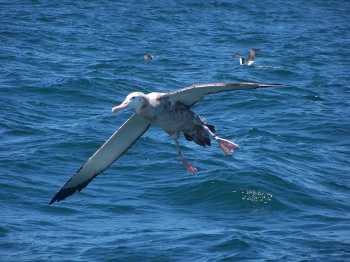A juvenile ACAP-listed and Critically Endangered Tristan Albatross Diomedea dabbenena that was tracked at sea from 21 December 2013 when it fledged from Gough Island in the South Atlantic to 07 January 2015 travelled a total of 186 684 km, an average of nearly 500 km a day for 383 days.
This record is in the Global Seabird Tracking Database of BirdLife International that has just passed five million data points. The database, originally called ‘Tracking Ocean Wanderers’, was established in 2003 when data on the movements of 16 species of albatrosses and petrels were brought together for the first time (click here). The database now holds information from five times as many species, provided by over 120 research institutes.

Tristan Albatross at sea, photograph by Martin Abreu
ACAP-listed Black-browed Albatross Thalassarche melanophris and Cory’s Calonectris borealis and Scopoli’s C. diomedea Shearwaters are among the most-studied species in terms of numbers of data points and tracks in the database. The tracking data can be viewed online.
Read more on the Global Seabird Tracking Database here.
John Cooper, ACAP Information Officer, 28 October 2015

 English
English  Français
Français  Español
Español